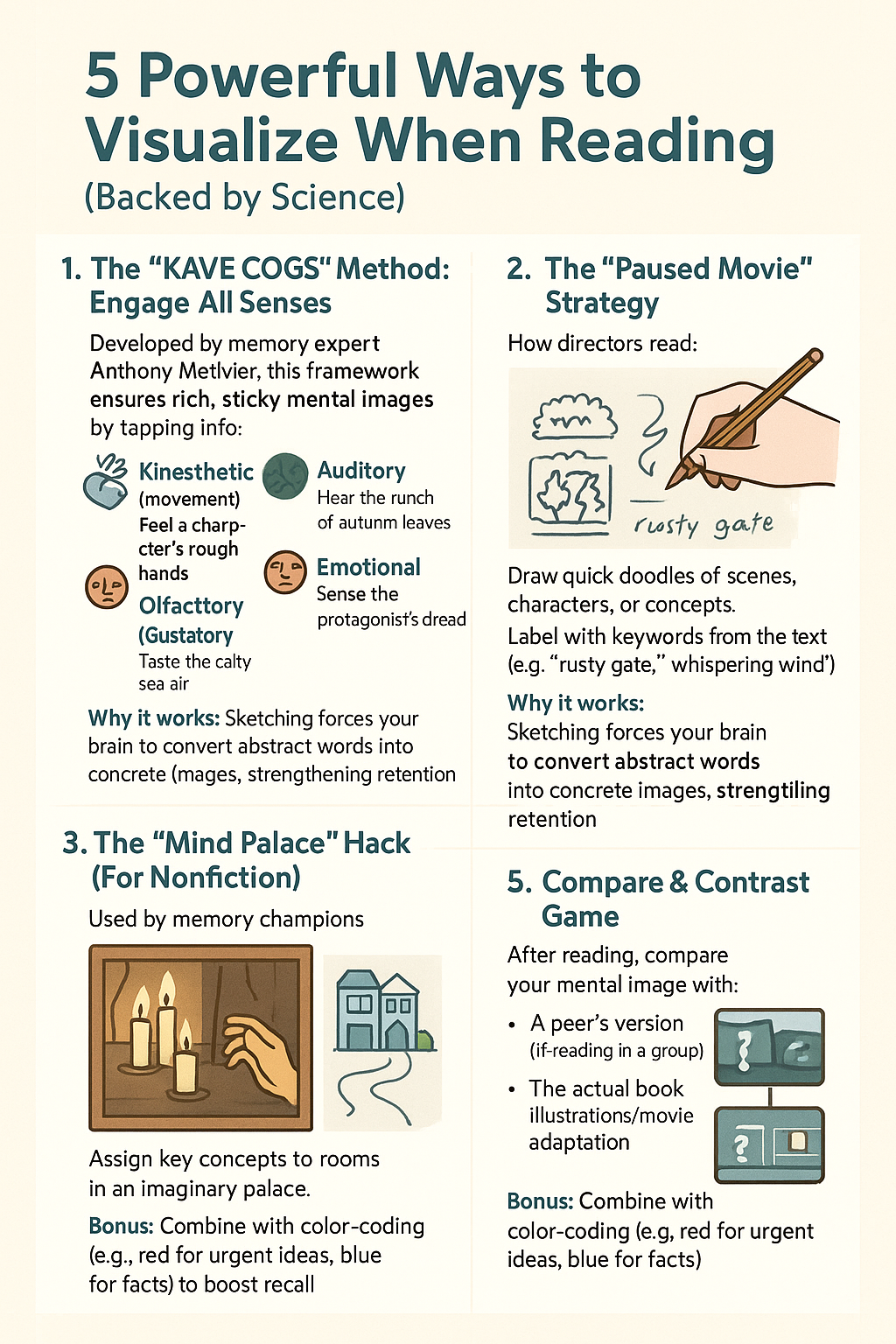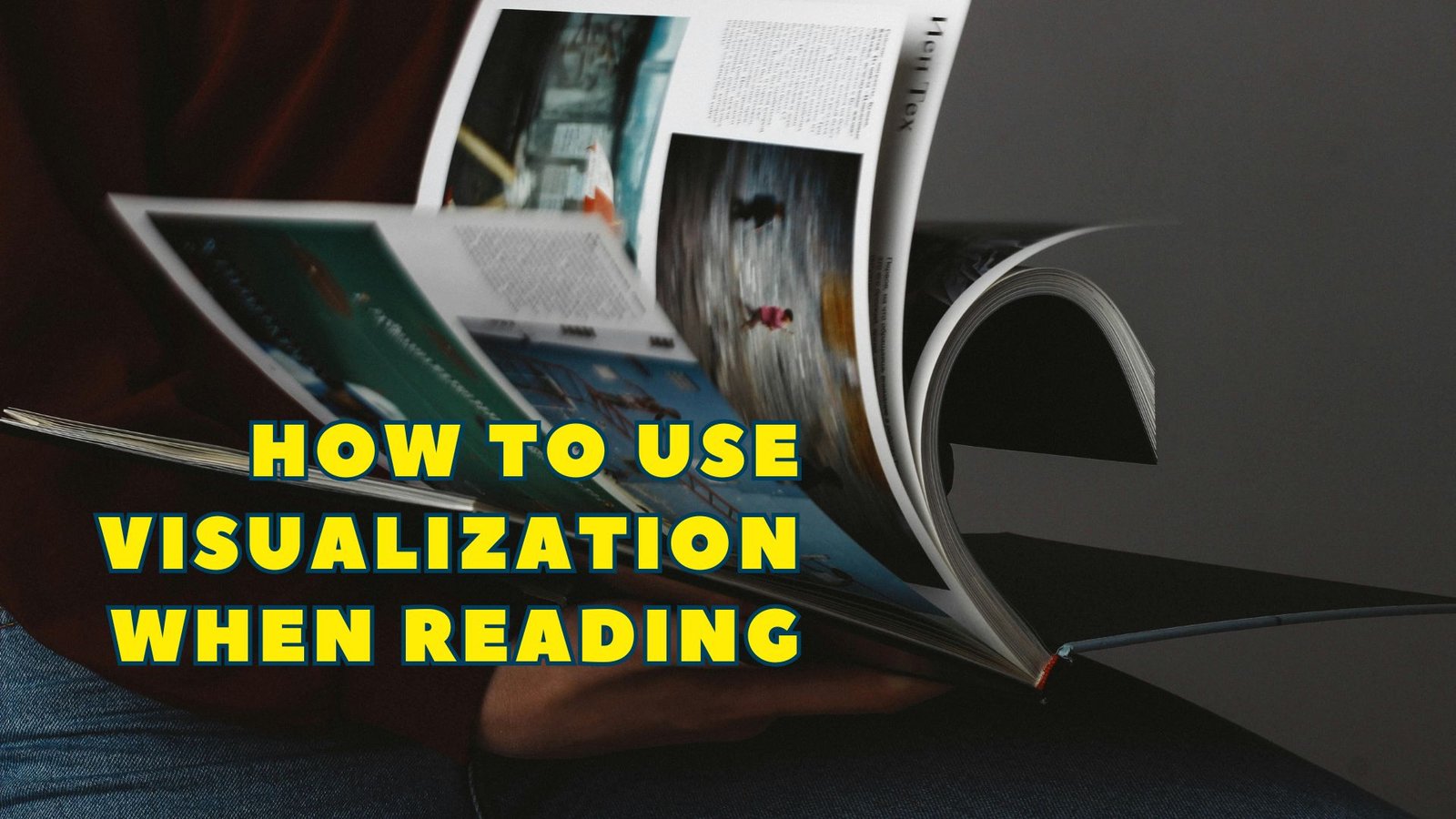Have you ever gotten lost in a book so deeply that you could smell the ocean breeze or feel the protagonist’s heartbeat?
That’s the power of visualization—the secret weapon of avid readers, speed learners, and memory champions.
Yet, most of us read passively, skimming words without truly experiencing them. What if you could train your brain to turn every page into a vivid mental movie, boosting comprehension, memory, and even reading speed?
Science confirms it: Visualization isn’t just for daydreamers. It’s a proven cognitive tool that helps students retain 42% more information, professionals absorb complex reports faster, and book lovers immerse themselves in stories like never before.
Here’s your ultimate guide to mastering visualization—with neuroscience-backed strategies, real-world exercises, and pro tips from educators and memory experts.

Why Visualization Works: The Brain Science Behind “Mind Movies”
Your brain doesn’t process text like a computer scanning data. Instead, it constructs mental models—multisensory simulations of what you’re reading. This “situation model” blends:
- Text clues (the author’s words)
- Your experiences (memories, emotions, senses)
Research shows:
✅ Stronger recall – Visualizing activates the occipital lobe (visual cortex), creating dual memory pathways.
✅ Deeper comprehension – Readers who visualize catch subtle details and infer hidden meanings.
✅ Faster reading – Mental “chunking” reduces subvocalization (silent speech), a key speed barrier.
But here’s the catch: Not all visualization is equal. Generic advice like “make a picture in your head” often fails. The best techniques are structured, multisensory, and strategic.
5 Powerful Ways to Visualize When Reading (Backed by Science)
1. The “KAVE COGS” Method: Engage All Senses
Developed by memory expert Anthony Metivier, this framework ensures rich, sticky mental images by tapping into:
- Kinesthetic (movement) – Feel a character’s rough hands.
- Auditory – Hear the crunch of autumn leaves.
- Visual – See the emerald-green forest.
- Emotional – Sense the protagonist’s dread.
- Olfactory/Gustatory – Taste the salty sea air.
Try it: Pick a descriptive paragraph. Pause after each sentence and run it through KAVE COGS.
2. The “Sketch-As-You-Read” Technique
Perfect for visual learners:
- Draw quick doodles of scenes, characters, or concepts.
- Label with keywords from the text (e.g., “rusty gate,” “whispering wind”).
Why it works: Sketching forces your brain to convert abstract words into concrete images, strengthening retention.
Pro tip: Use graphic organizers like “Character Action Figures” to visualize book personas.
3. The “Paused Movie” Strategy
How directors read:
- Read a passage.
- Pause and “frame” the scene like a film still.
- Ask:
- What’s the lighting? (e.g., gloomy dusk)
- Camera angle? (e.g., close-up on a trembling hand)
- Soundtrack? (e.g., tense strings)
Example: In Harry Potter, J.K. Rowling’s “great hall with floating candles” becomes a cinematic moment when visualized.
4. The “Mind Palace” Hack (For Nonfiction)
Used by memory champions:
- Assign key concepts to rooms in an imaginary palace.
- For example, place “photosynthesis” in a sunlit greenhouse or “WWII timeline” along a hallway.
Bonus: Combine with color-coding (e.g., red for urgent ideas, blue for facts) to boost recall.
5. The “Compare & Contrast” Game
Sharpen accuracy:
- After reading, compare your mental image with:
- A peer’s version (if reading in a group).
- The actual book illustrations/movie adaptation.
Insight: Differences reveal how your biases shape interpretation—a critical thinking workout!
When Visualization Fails (And How to Fix It)
Problem 1: “I can’t see anything!” (Aphantasia)
- Solution: Focus on other senses (e.g., sounds, textures) or spatial relationships (e.g., mapping a scene like a blueprint).
Problem 2: “My mind wanders.”
- Solution: Use a bookmark pacer (move a pen under lines) to stay anchored.
Problem 3: “Abstract texts (e.g., philosophy) don’t ‘look’ like anything.”
- Solution: Visualize metaphors (e.g., “time is a river” → imagine a flowing stream).
Pro Tips From Teachers & Speed Readers
📖 For kids: Start with high-imagery books like Where the Mountain Meets the Moon.
⏳ For busy adults: Dedicate 5-minute visualization burstsduring commutes or breaks.
🎧 Audiobook lovers: Pair listening with mindful walks to “act out” scenes.
Your Challenge: Become a “Director-Reader”
Tonight, try this:
- Pick a book (fiction works best initially).
- Read 1 page slowly, using KAVE COGS.
- Rate your immersion on a scale of 1–10.
Repeat for a week—you’ll notice sharper focus, richer recall, and books that feel alive.
💬 Now I’d love to hear: What’s the most vivid “mind movie” you’ve ever created while reading? Share below!
Sources & Further Exploration
- CPP.edu: Advanced Visualization for Critical Reading
- Magnetic Memory Method: Multisensory Visualization
- Basmo: Why Visualization Matters
- Creative Classroom Core: Visualization Strategies
Loved this? Share with a fellow bookworm!

